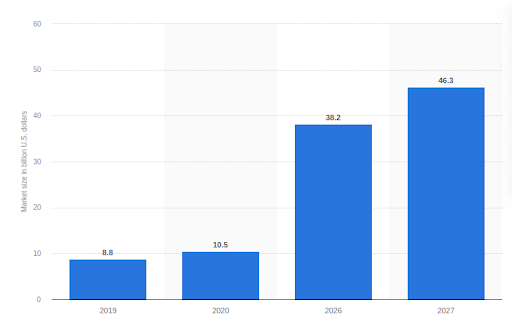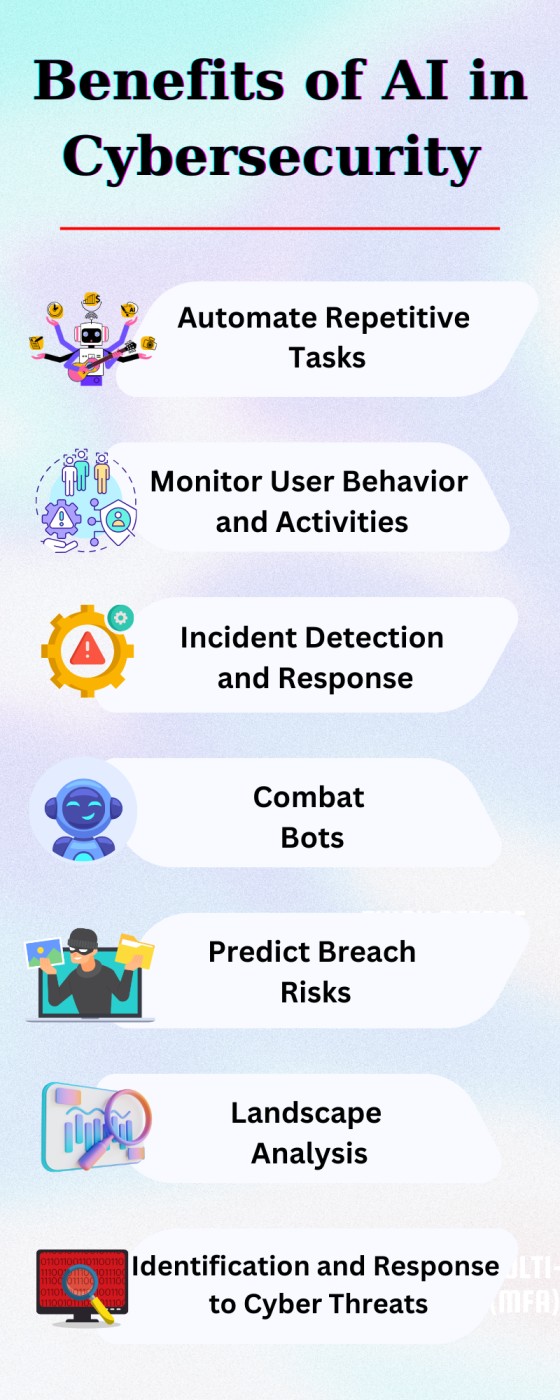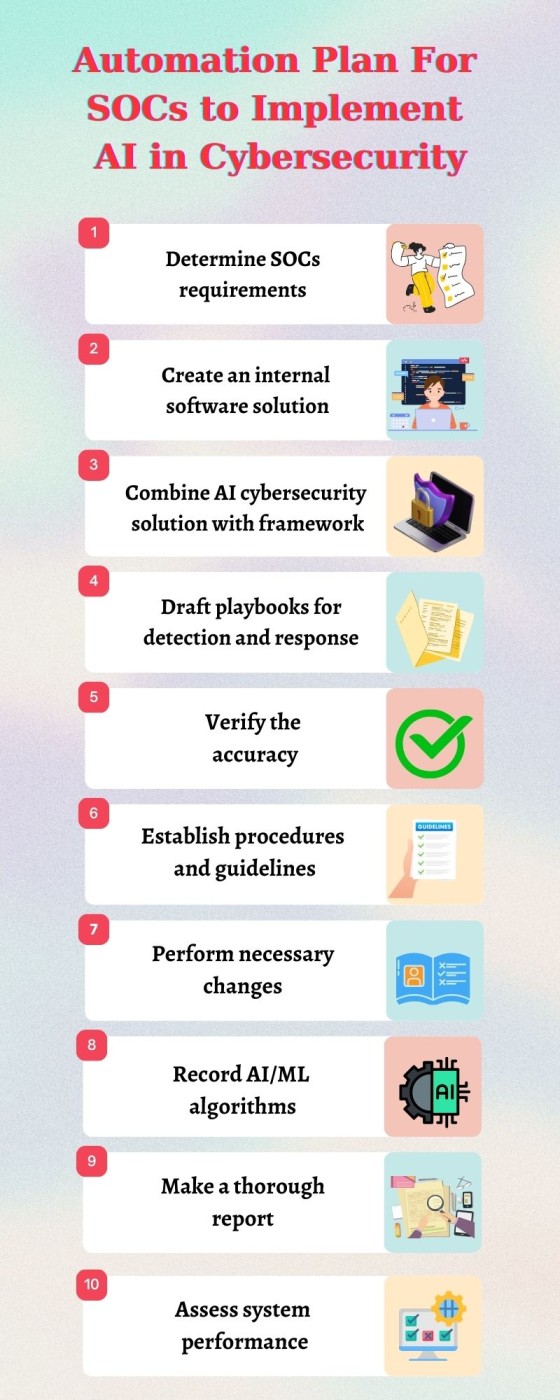In a world defined by digital transformation, the primary concern for businesses is safeguarding their virtual assets against an ever-evolving landscape of cyber threats. Today, legacy or even modern systems encounter several obstacles—sophisticated cyberattacks, a massive attack surface, a pile of data, and expanding infrastructure complexity.
All the above aspects impede an enterprise’s ability to safeguard data, handle user access, and instantly detect and respond to security threats. Additionally, a hundred billion time-varying signals need to be examined to calculate the risks correctly. Accessing and enhancing cybersecurity posture can be a dominating task for any organization.
The use of AI in cybersecurity assists enterprises in scaling down breach risks and enhancing security posture. A cybersecurity consulting company can play a crucial role in implementing AI and ML in information security, as these technologies can immediately access millions of events and discover several types of threats.
AI and ML in cybersecurity recognize everything from malware exploiting zero-day vulnerabilities to detecting risky behaviors that could result in a phishing attack or the download of malicious code. As they progress, they draw upon historical data to determine and preemptively address emerging forms of attacks.
Understanding the Foundation of Artificial Intelligence
By 2027, the value of AI for cybersecurity is expected to reach 46.3 billion dollars, up from over ten billion dollars in 2020. This is because Artificial intelligence has the capability to comprehend, learn, and act based on collected and deduced information for better outcomes. The role of artificial intelligence in cybersecurity involves integrating AI technology to streamline intricate procedures and increase dependability and security.

Today, artificial intelligence functions in three ways:
- Assisted intelligence enhances the work that individuals and organizations are already undertaking. They help perform tasks with accuracy and efficiency.
For Example— Speech recognition software and predictive text algorithms. - Augmented intelligence opens up new possibilities for individuals and organizations to do stuff they couldn’t otherwise do.
For Example— Machine learning algorithms and chatbots. - Autonomous intelligence, being created for the future, includes machines that act independently.
For Example— Self-driving cars and drones.
Subsets of AI in Cybersecurity
It is possible to say that AI has some characteristics of human intelligence— a database of domain-specific information, learning mechanisms, and application mechanisms. AI technology incorporates machine learning, deep learning, neural networks, and expert systems, which are subsets of artificial intelligence. All these subsets combined help strengthen an enterprise’s cybersecurity.
-
Machine Learning
Machine learning assists in detecting threats by regularly monitoring the behavior of the network for peculiarity. ML engines process huge amounts of data in real-time to uncover crucial incidents. These methodologies enable the detection of insider threats, unidentified malware, and even policy violations.
-
Neural Networks
Neural networks help build intelligent ID/IP systems by accessing traffic more accurately. It also reduces the number of false alerts and helps cybersecurity teams differentiate between good and bad networks.
-
Deep Learning
Deep learning algorithms can analyze critical data patterns and check data access and transfer to block unauthorized data leakage. These AI models evaluate the data flow of various networks, look for any vulnerabilities, and automatically apply security measures to protect crucial information. These days, deep learning-based image identification frequently outperforms human vision in various applications, including scan analytics, AI software development in healthcare, and autonomous cars.
-
Expert Systems
Utilizing expert systems offers flexibility in choosing the required values for security analysis. SOC analysts can determine the values based on input data; even default values can be used in vital places. Through carefully chosen bodies of knowledge, they mimic how human experts think, solve problems, and make judgments utilizing fuzzy rules-based reasoning.
Benefits of AI in Cybersecurity
Machine learning and AI have become indispensable to security because they can track a wide range of cyber risks and analyze millions of data. The technology functions best when it is continuously learning from its previous data. Let’s examine the impact of AI on cybersecurity.

1. Automation of Repetitive Tasks
Security Orchestration, Automation, and Response (SOAR) systems assist enterprises in automating repeated and lengthy tasks like identity verifications, threat analysis, and vulnerability enrichment. Moreover, solutions such as UEBA (User and Entity Behavior Analytics) automatically spot anomalies in various endpoints, servers, networks, and routers.
AI automation in cybersecurity plays a crucial role in testing apps, enabling you to test as you build applications parallelly. It assists in identifying errors early, ensuring speed and security in application development.
AI-managed vulnerability scanning & management solutions can and analyze every vital data source automatically or semi-automatically.
- Software code sources
- Bug reports
- IT system logs
- Data breach reports
- Network traffic records
- Threat intelligence feeds
2. Monitoring User Behavior and Activities
It is imperative to understand how employees operate in a workplace to identify and deal with potentially harmful and abnormal behavior. Using artificial intelligence for cybersecurity helps cybersecurity consultants conduct many tasks, such as monitoring user behavior on corporate networks. The AI systems check for compromised user accounts, malicious files, and infected hosts using a behavioral pattern to spot anomalies.
3. Incident Detection and Response
Another popular example of AI in cybersecurity is its capability to identify and prioritize different threat types and provide alerts in the right way. The notification alerts could be of different stature, such as identifying malware or files even before they are opened, providing pertinent information about the cleanup, and automating ticket generation.
AI-powered cybersecurity software built for identifying incident detection and response helps in reducing time and speeding up repair times. It also empowers enterprises to take necessary and proactive measures before any unforeseen incident occurs.
4. Combatting Bots
Thanks to intelligent machines, it is now possible to nullify hacking attempts and shut down connections and sessions performed by harmful bots. Utilizing artificial intelligence in system security helps in productive web server management, copyright protection, social networks, and apps. AI assists in combating bots from various industries, like online gaming and entertainment. AI in supply chain management helps warehouse management systems identify weaknesses, gaps, and risks and eliminates fake bots.
5. Prediction of Breach Risks
AI cybersecurity solutions assist in determining the IT inventory, which is a precise list of people, things, and programs with various levels of access. AI-powered cybersecurity can now forecast the likelihood of company systems being penetrated by taking into account the asset inventory and threat exposure factors. For example, Generative AI development generates realistic training data for ML models to find and hinder attacks. Generative AI in cybersecurity can assist in identifying harmful codes, fake websites, and phishing emails.
6. Landscape Analysis
Updating old systems and developing hybrid networks and platforms have become essential corporate practices as remote work becomes the new standard. When it comes to corporate security, employees who use cloud-based apps for work have gone outside the traditional walls of an organization. Endpoint security resources are required to manage transactions, communications, apps, and connections in this multi-location work environment.
AI in cybersecurity is demonstrated by SOC analysts who leverage the technology to support, reach, and scale across various endpoints. Additionally, AI and ML can be used with .NET apps to analyze data from different sources, like network traffic and logs. It would allow enterprise organizations to restrain and investigate incidents immediately.
7. Identification and Response to Cyber Threats
Artificial Intelligence has applications in cybersecurity, such as analyzing user behavior and identifying anomalous deviations in business by inferring patterns. It makes it possible to identify weak points in the system and swiftly fix them to stop such assaults in the future. Furthermore, ML for cybersecurity is trained on various malware occurrences, which can result in the proactive identification and forecasting of malware that may compromise the IT network.
Examining real-world examples of initiatives centered around the application of AI in cybersecurity is essential to determining the role of AI and machine learning in cybersecurity.
Popular Examples of Companies Using AI for Cybersecurity
Several real-world instances support the use cases for AI in cybersecurity that we discussed above. Next, let’s examine the most prominent ones.
- Google utilizes AI to analyze mobile endpoint risks and protect the increasing number of mobile devices.
- Additionally, Zimperium and MobileIron announced their partnership to assist companies in implementing AI-based mobile anti-malware solutions.
- The Darktrace Enterprise Immune System is another example of AI in cybersecurity. It is built on AI and ML and models the behaviors of every person, device, and network to analyze specific patterns. It automatically detects abnormal behavior, alerting businesses in real-time.
- Gathering and storing network metadata, Cognito adds distinct security insights to it, which are then utilized for identifying and prioritizing attacks.
Automation Plan For SOCs to Implement AI in Cybersecurity
Here’s how we implement a SOC automation plan when we work on a project as an AI security company:

1. Determining the SOCs requirements of the organization by performing a needs assessment.
2. Creating an internal software solution to address the AI-related business requirements in cybersecurity.
3. Combining the recently developed AI cybersecurity solution with the current security framework.
4. Drafting playbooks for detection and response that will be applied as a corporate standard.
5. Verifying the accuracy and proper operation of the system.
6. Establishing procedures and guidelines for utilizing the technology and calculating the influence of AI in cybersecurity.
7. Keep an eye on the system’s performance and make changes as needed.
8. Recording the AI/ML algorithms used in the procedures involved in implementation.
9. Making a thorough report outlining the approach, findings, and suggestions for future advancements for AI in network security.
10. Assessment of the system’s performance in terms of security incident response and AI threat detection.
How Does SparxIT Help Enterprises Implement AI for Cybersecurity?
The capability to detect and respond to futuristic threats is one of the main issues faced by security operations centers (SOCs) today. Today’s hackers are more adept at initiating assaults against a compromised system by utilizing cutting-edge technology such as generative AI and deepfake. This condition generates a blind spot that necessitates the strategic use of AI cybersecurity solutions.
Being a prominent AI development services provider, automating systems is the main goal of our team. We work on diverse enterprise-grade artificial intelligence use cases in cybersecurity for scalability and productivity. We integrate AI for cybersecurity, with an emphasis on SOC software in an auto-detection and notification mode.
Conclusion
Artificial Intelligence has become necessary to support human information security teams in recent years. Since humans cannot scale to defend the dynamic business attack surface effectively, artificial intelligence offers critical analysis and threat detection that cybersecurity professionals may use to lower breach risk and strengthen security posture.
AI can easily conduct risk assessments, provide incident response guides, and detect malware for any organization. It allows cybersecurity professionals to support their infrastructure in a more productive way to enhance the quality of work.
FAQs on Artificial Intelligence in Cybersecurity
Q: How does Artificial intelligence enhance cybersecurity?
A: It automates threat detection and response via machine learning, surpassing traditional software-driven methodologies in countering evolving cyberattacks.
Q: What are the big hurdles in using AI in cybersecurity?
A: Some major obstacles in utilizing artificial intelligence for cybersecurity are mentioned below—
- AI-led ransomware attacks
- AI phishing attacks
- Denial of service (DoS) attacks
- Deepfake attacks
You must consult a dedicated cybersecurity service provider with vast expertise, skills, and knowledge to protect your enterprise against these threats.
Q: How can businesses ensure the proper use of AI for cybersecurity?
A: Enterprises can adhere to stringent testing processes for AI algorithms and models. Furthermore, they should put emphasis on the latest security patches for software products and follow secure coding practices.



